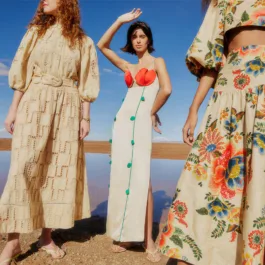From colourful socks to statement suits and dapper cravats, it’s never been more fashionable to add a touch of personality to your polished, professional look. However, there is a such thing as not enough “work” and too much “play” – especially if your industry or office culture leans towards the conservative. For those looking to up their style quotient without going over the top, it’s all about the strategic use of classic accessories with timeless sophistication. Enter: the pocket square.
For the sartorially uninitiated, a pocket square – also known as a pocket handkerchief – is a piece of fabric that is folded and worn in the upper left pocket of a suit jacket or blazer. The type of material used varies depending on the occasion, and the colour is usually chosen such that it provides a pleasant contrast to the suit or blazer it’s worn with. It’s a small accessory, indeed, but it can really impact your overall look.

Pocket Squares: A History
As with many simple and classic garments, if we look back through history, we can trace the use of the pocket square to ancient times. Some say the Greeks carried around perfumed strips of cloth so they could cover their noses and keep out the unpleasant odours of the city. Others say the Egyptians were the first pocket square wearers, donning decorative pieces of dyed red cloth as a symbol of wealth. The Romans also used fabric similar to pocket squares, which they employed to signal the start of gladiatorial contests. And, much later, devout Catholics in medieval times wore white handkerchiefs on their arms as a sign of their faith.
Another popular anecdote refers to King Richard II of England as the figure who popularised wearing handkerchiefs as accessories. Renowned for his elegance – bordering on extravagance – he added pieces of brightly coloured silk decorated with intricate embroidery to his expansive wardrobe. The original purpose was to clean his hands and face, but in the decades that followed, small decorative cloths could also be seen on the outfits of important figures in European high society.
In terms of shape, we can thank Louis XVI of France: in 1784 he issued a royal decree stating that every pochette made in France had to have a length equal to its width. Et voilà, the pocket square.
A point of clarification before we move on: a pocket square is not to be confused with a handkerchief. The latter is a functional piece of cloth – often simple, white, made of cotton and primarily used to wipe the face or blow the nose; it’s a vintage (and more environmentally friendly) version of disposable tissues. Pocket squares, on the other hand, are generally made from finer fabrics like silk, linen or cashmere, come in a variety of eye-catching patterns and colours, and are purely decorative – you certainly don’t want to be wiping up messes with your pocket square!
How To Wear A Pocket Square
A favourite through the ages, pocket squares have never gone away. And let’s be honest, they probably never will. Even when the prevailing trends favour more casual styles, you can never go wrong with a classic suit or smart blazer – and a pocket square for added flair.
So, how should you wear it? Well, it’s up to you: there are thousands of different styles you can create simply by choosing different, colours, prints and sizes, as well as different ways to fold it. Let’s have a look at some of the options.

[Photos courtesy Camilo Márquez Freire]
A Colourful Touch
The best thing about pocket squares is their ability to enhance the colour palette of your look: by contrasting the colour of your square with the hues of your suit or blazer, you can render the overall effect a more sophisticated, casual or trendy note. If you’re wearing a tie, don’t add a pocket square in exactly the same colour. Ideally, choose a shade from the same colour family as your tie and in a similar print.
If the occasion is formal, requiring a tuxedo or a two-piece suit in grey, blue or black, opt for a white silk pocket square with a miniature print that contrasts with your tie. Don’t be afraid to use more than one colour.
If you have something more casual in mind, opt for vibrant colours and striking prints. Remember: the more detailed the print, the less complicated your folding method should be, to make it stand out more.
Also, don’t shy away from mixing different materials and textures, as this helps create a more layered look. Choose cotton pocket squares for a more classic style, and finer materials like linen or silk if you’re a more experienced wearer of pocket squares. Avoid using pocket squares larger than 25cm; this will ensure they stay in the right position and don’t create unwanted bulk in your jacket or blazer.
It’s All In The Fold
The easiest way to ensure your pocket square reaches its full potential as a stylish accessory is by folding it in a way that makes it stand out – whether that means holding it gently and passing it through your fingers for a relaxed texture, or using the tips to create a visual effect that contrasts with the fabric of your jacket. If you’re new to using pocket squares, here are three different folds for three key occasions:
The Everyday Fold
Cup the pocket square in the centre with your fingers and twist it round, using the forefinger and thumb of your opposite hand. Put it in your pocket, tips down, for a casual and relaxed look.
The Formal Fold
With the square spread out on a flat surface, fold it vertically in half. Now, fold again, this time horizontally. Fold it to the centre again, and put it in your pocket with the tips facing upwards. This fold is perfect for formal looks or corporate events.
The Stylised Fold
Spread the pocket square out and fold it diagonally. Make sure the corners are parallel, but not on top of each other. Bring the two ends to the middle to create a rectangle, where the two corners protrude at the top. Adjust it for the size of the pocket, and wear it with the corners showing. Use your pocket square to show off your style.
And Now: Break The Rules!
These days, pocket squares are used to add a personal touch to any suit or tuxedo, as they were in the past, but they can also be worn more informally with blazers and jeans. However, as with all sophisticated garments, they must be chosen carefully: the seams should be hand-stitched and, when it comes to materials, choose silk, linen, cotton or top-quality cashmere.
The biggest fashion mistake you could make in general is appearing too coordinated and over-analysed – it looks forced and unnatural. The same goes for pocket squares. You should aim for a harmonious combination of contrasting and complementary colours, prints and textures, but this doesn’t mean everything has to be perfect. In fashion, nothing is written in stone: so mix it up and have some fun! Use prints and eye-catching colours, and pay attention to detail. You can even wear pocket squares with other types of formal jackets – all you need is, well, a pocket and a little personality.














Sorry, the comment form is closed at this time.